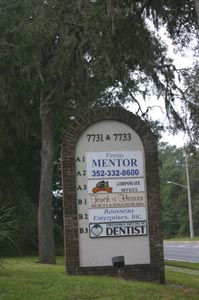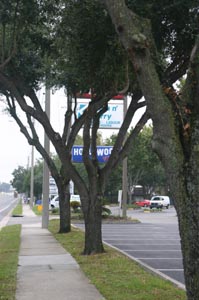Home > Site analysis > Evaluate above ground characteristics > Signs
Signs
Signs and trees sometimes conflict with each other. To help prevent this, plant small trees near tall signs and large trees near low signs. Large-maturing trees could be in the way of a low sign for several years after planting, but lower limbs can be thinned and eventually removed so the sign remains visible. A tall canopy over a sign directs peoples eyes to the sign. Training trees to one central trunk is the best way of keeping signs visible while maintaining tree canopy in urban landscapes.
Trees can block building facades, interesting architectural features and signs in downtown areas. There are several solutions to this potential problem. Large sized nursery stock can be purchased which has most branches taller than low signs.
Trees with a thin canopy can be selected to allow people to see. Trees with an upright or columnar habit will not spread to cover adjacent buildings and signs. Trees can be regularly thinned to allow people to see through them, but this requires regular maintenance. The signs on the buildings can be lowered to make them visible under the tree canopy.
 |
 |
Here, a short sign was placed beneath an established tree with the lowest branches removed, and the sign is easily visible. |
These trees have been excessively raised and thinned in the lower canopy to open the view to the sign in the background. A better option would have been to select a tree with one central trunk and trained it regularly to grow over the sign. |
This is a good example of why maintenance practices should be evaluated in the tree selection process. Without regular pruning, the sign here is swallowed between the two trees. |
|


